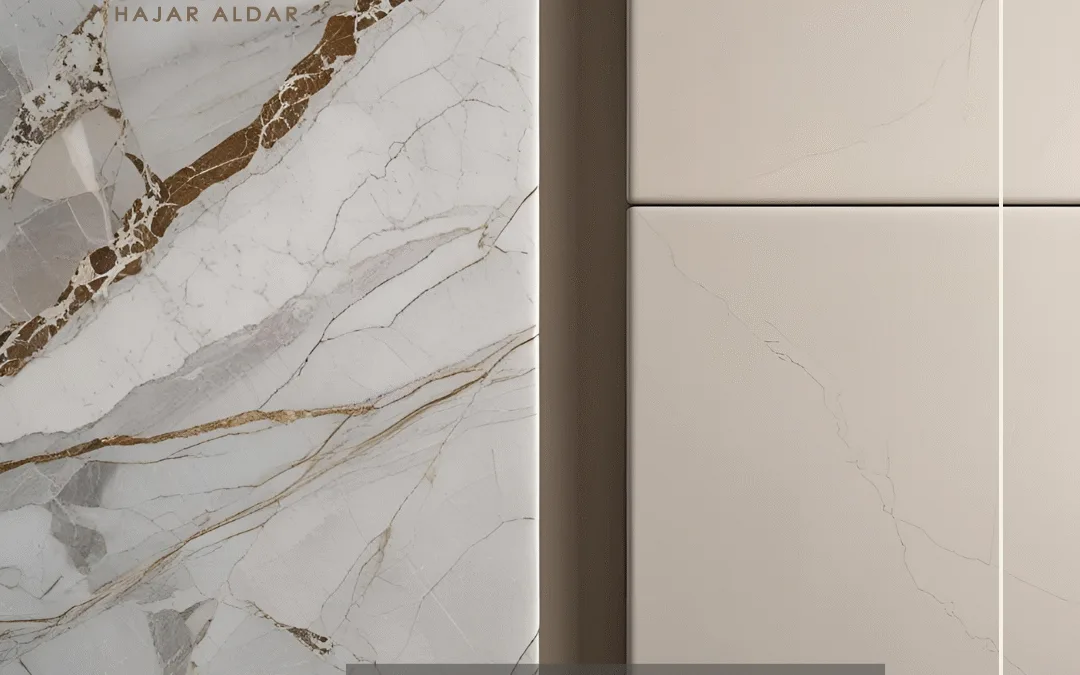Introduction
When considering flooring or wall finishes in homes or commercial projects, a common question arises: which is better, marble or ceramic? Although both materials are widely used, marble is often preferred by architects and interior designers for many reasons that go beyond mere appearance. In this detailed article, we explore why marble outperforms ceramic in terms of beauty, performance, real estate value, and durability.
-
Natural Beauty and Uniqueness
Marble features unique natural veins that cannot be replicated. Each marble slab is a work of art crafted by nature over thousands of years. Unlike ceramic, which is manufactured with repeated printed patterns, marble offers a sense of exclusivity and individuality in every tile.
-
Marble: Attractive, random, and varied patterns.
-
Ceramic: Repeated printed designs.
This difference makes marble the preferred choice in spaces where luxury and natural beauty are emphasized.
-
Real Estate Value
Having marble in any property directly increases its market value. Marble is a luxury material used in hotels, palaces, and upscale villas, making it an attractive feature for potential buyers.
While ceramic is common in ordinary homes, it does not convey the same sense of luxury or elegance.
-
Durability and Longevity
Marble is a strong and durable natural material that can last for decades if properly maintained. Unlike ceramic, which can crack or break easily if a heavy object falls on it, marble resists wear and tear better over long-term use.
-
Marble: Can be polished and restored to look like new; withstands heavy use in busy areas.
-
Ceramic: Prone to breaking; often requires full replacement when damaged.
-
Luxury and First Impressions
Entering any home, hotel, or reception hall with marble floors creates an unforgettable impression. Its natural shine and soft colors add a refined and professional atmosphere.
While ceramic can look nice, it does not have the same visual impact or psychological effect as marble.
-
Thermal Conductivity
Marble naturally retains coolness, making it ideal for homes in hot climates such as the Arabian Gulf. It also works well in underfloor heating systems by storing heat or coolness.
Ceramic is also thermally conductive, but marble retains temperature longer, offering greater comfort in summer.
-
Eco-Friendliness
Marble is a natural material free from volatile organic compounds (VOCs), making it safe for indoor environments, especially in homes with children or allergy sufferers.
Ceramic, on the other hand, is made from various components and requires energy-intensive production processes, possibly involving chemicals and glazes.
-
Restorability and Lifespan Extension
When marble gets scratched or stained, it can be easily polished or treated to restore its natural appearance. In contrast, ceramic cannot be restored this way; damage usually means full tile replacement.
-
Color and Finish Options
Marble comes in a variety of natural colors such as white, gray, beige, green, and black, with finishes that can be glossy or matte according to preference. Since the color is part of the stone itself, it does not fade over time.
Ceramic can be manufactured in any color or design, but the surface layer can fade or wear off over time, especially in high-traffic areas.
-
Use in Luxury Design
Marble is widely used in upscale details such as:
-
Accent walls
-
Kitchen countertops
-
Custom tables
-
Luxury hotel bathrooms
While ceramic is mainly used as a practical material for floors or walls.
-
Effect on Lighting and Space
Marble naturally reflects light, giving rooms a soft illumination and a sense of spaciousness. This makes it ideal for smaller spaces that need to appear larger and brighter.
Ceramic may have a manufactured shine but lacks the dynamic lighting effect of marble.
Conclusion
Marble is more than just a finishing material; it is an architectural statement expressing taste, luxury, and elegance. Although its cost is higher than ceramic, the return on investment is tangible in terms of beauty, market value, and long-term performance.
Ultimately, choosing marble over ceramic is a smart decision for those seeking true distinction, especially in homes considered long-term investments.
Because details make the difference — choose marble… and choose luxury from the start.


